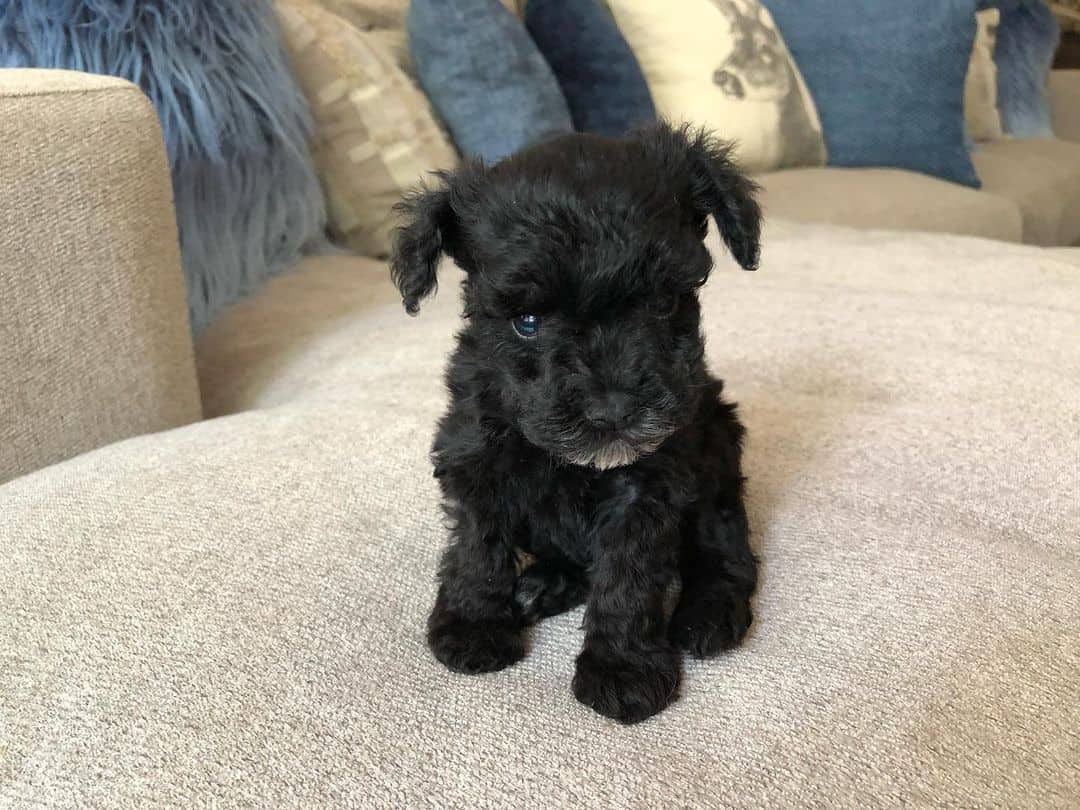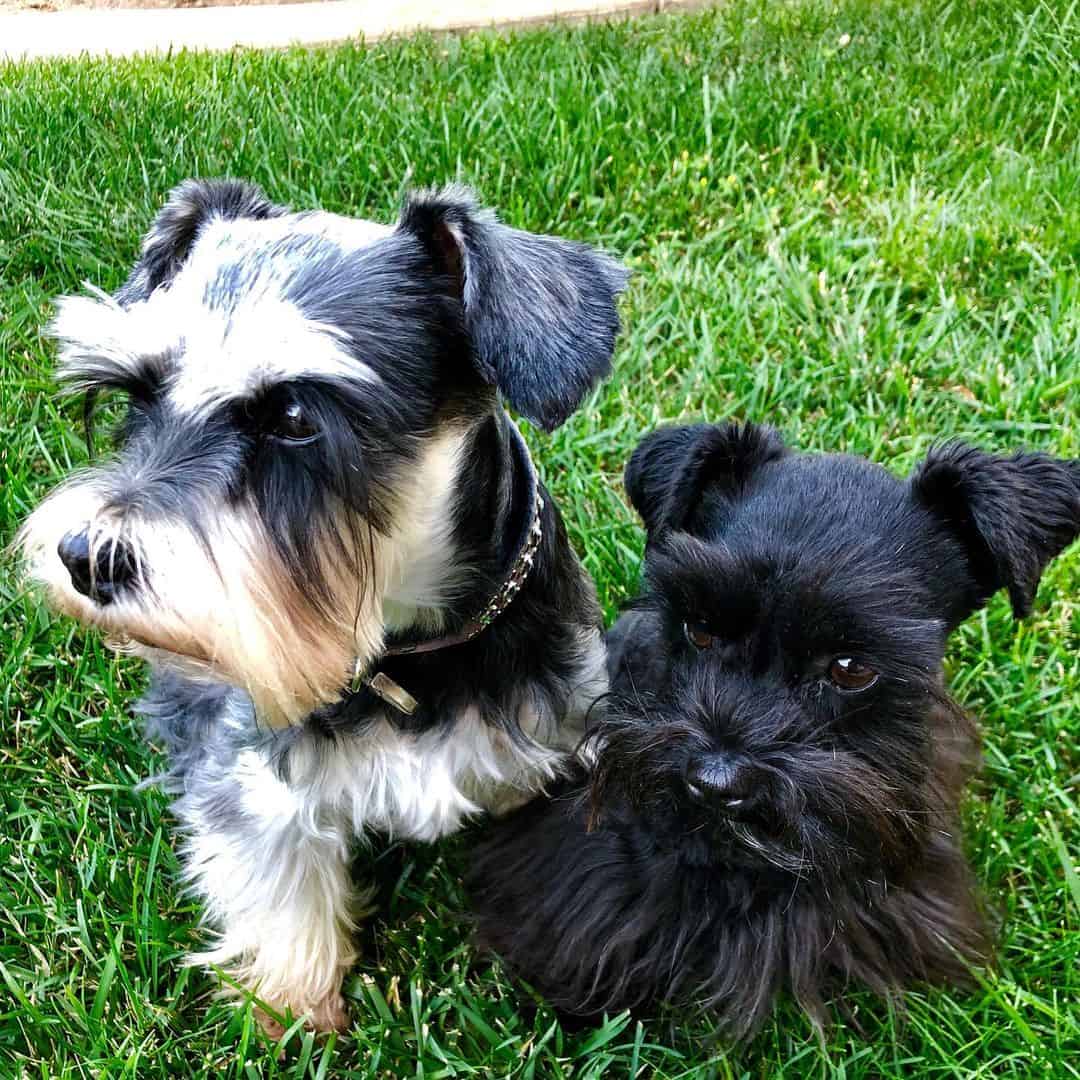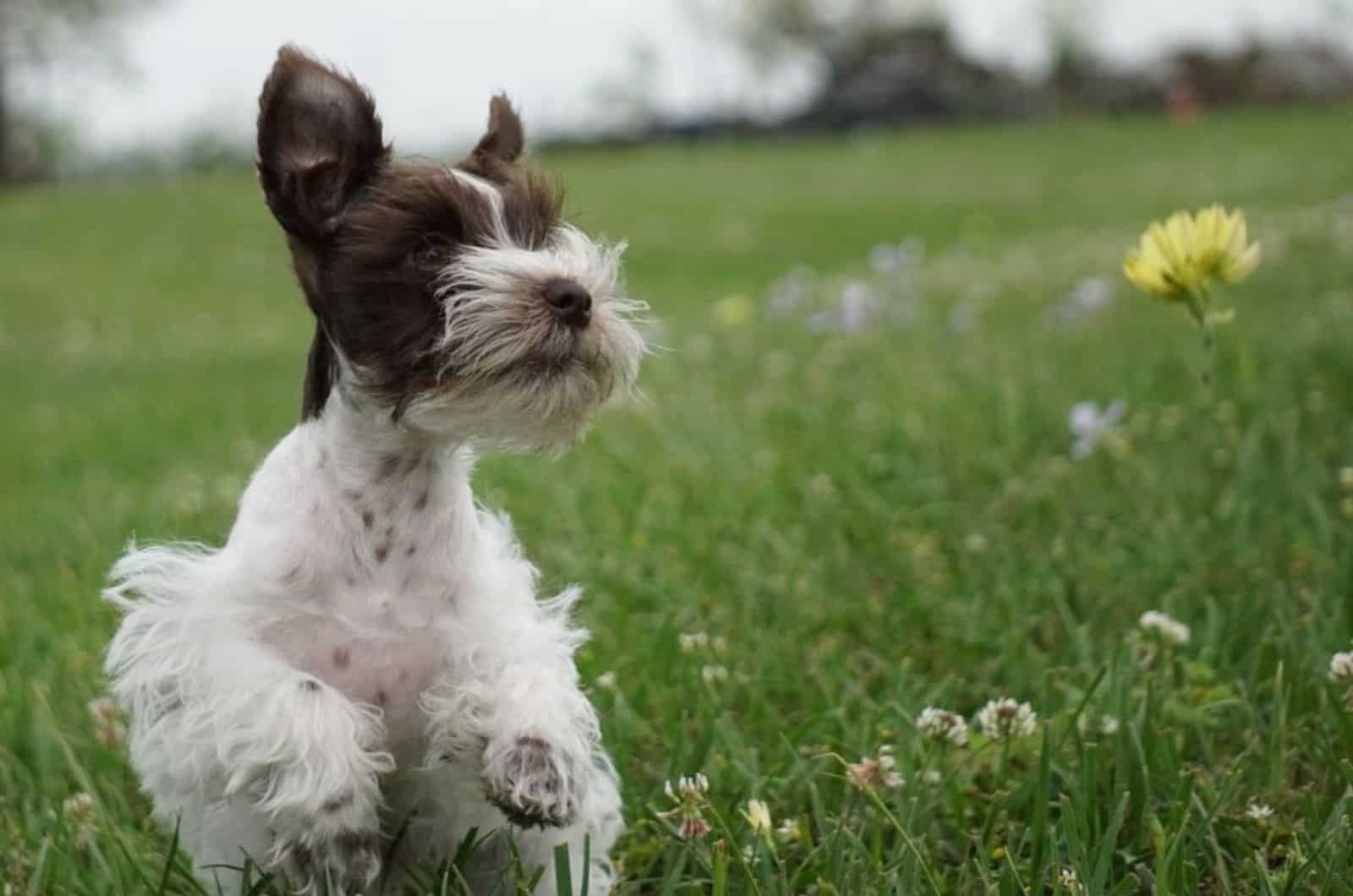If you’re an avid dog aficionado, you probably already know all there is to know about the Teacup Miniature Schnauzer—but if you’re like most people, you’ve probably only heard of them or seen pictures of them online and you might be wondering what they’re like, what makes them unique, how they are bred, etc.
The truth is, the Teacup Schnauzer is not a separate breed in itself but is actually a smaller version of a purebred Miniature Schnauzer.
The term Teacup is used to describe dog breeds that are so tiny that they could fit into a teacup—breeds like the Teacup Yorkie, Teacup Chihuahua, Teacup Cavalier, Teacup Pomeranian, and of course, the Teacup Schnauzer (among other breeds) fit into this category.
Schnauzers, in general, are a German dog breed that is characterized by their wiry coats, bushy brows, and distinct beard-like whiskers that lend them the appearance of an old wise man reincarnated in a dog’s body.
The Teacup Schnauzer, being a smaller version of the Standard Schnauzer, stands at only 5 to 12 inches at the withers and weighs between 5 to 7 pounds—and while smaller dog breeds tend to have a longer life expectancy than larger ones, Teacup dog breeds are prone to some severe health problems due to their tiny stature.
So, if you’re interested in learning all there is to know about this tiny designer breed, read on to find out what exactly makes a Teacup Miniature Schnauzer unique.
The Teacup Miniature Schnauzer

Photo from: @pristineschnauzers
The Miniature Schnauzer was originally developed in the late 1800s by crossbreeding Standard Schnauzers with smaller dogs, like the Miniature Poodle and the Affenpinscher.
Teacup Miniature Schnauzers were subsequently developed from Miniature Schnauzers via several different methods—which we’ll get to in a minute.
Schnauzer dogs, in general, are known to be intelligent, friendly, well-tempered, affectionate, and obedient dogs that love to be around their owners—which is why they make wonderful family pets.
That said, even though there already was a smaller version of the Standard Schnauzer, there was a growing demand for an even smaller version of the breed during the ‘90s—which is around the time when the first Teacup Miniature Schnauzers were created to meet this demand.
It’s fairly obvious why a breed like the Teacup Schnauzer is so popular—its incredibly tiny, teddy bear-like stature, coupled with the personality of a large dog, is probably the reason behind the Teacup Schnauzer’s ever-growing popularity.
Small dogs take up less space, eat less, exercise less, and love equally as much as larger dogs—but one downside to owning such a tiny dog is that they’re often prone to certain health problems, mainly due to the fact that they’re so small.
This is why it’s crucial to know all of the pros and cons (especially the myriad of health concerns associated with tiny breeds like this one) before committing to a Teacup Schnauzer.
What’s The Difference Between Teacup, Toy, And Miniature Schnauzer Puppies?
The difference between the three smaller Schnauzer breeds is very simple, they’re all comparatively smaller variations of the same breed, and they all descend from the Standard Schnauzer (which, in itself, is yet again a smaller version of the Giant Schnauzer).
If we take a look at the Miniature Schnauzer growth chart, we can see that the Mini Schnauzer is a smaller version of the Standard Schnauzer, and the Toy size and Teacup Schnauzers are just smaller varieties of the same breed. Of course, there is also a difference in how all of these variations are recognized by the American Kennel Club.
The AKC’s Miniature Schnauzer breed standard states that dogs of this breed must conform to the following guidelines: they must stand between 12 and 14 inches at the withers and weigh between 12 and 21 pounds—acceptable colors are black, black and silver, and salt and pepper, other colors, such as parti and merle, are not acknowledged.
The Toy and Teacup Schnauzer varieties are much smaller than the Miniature Schnauzer, with Toy Schnauzers weighing less than 12 pounds and Teacups Schnauzers weighing less than 7 pounds.
The most important thing to note is that Toy Schnauzers and Teacup Schnauzers are not recognized by the AKC as separate Schnauzer breeds and that they’re not allowed to compete in conformation shows like the Westminster Kennel Club Dog Show.
The practice of breeding these smaller variations of the Mini Schnauzer is still fairly controversial, and these tiny designer dogs are still officially categorized as Miniature Schnauzers.
However, given the fact that both Toy and Teacup Schnauzers are still technically Miniature Schnauzers, owners can register their dogs with the American Kennel Club as purebred Miniature Schnauzers—as long as they are actually purebred.
How Are Teacup Schnauzers Bred?

Photo from: @schnabaaba
There are basically three different ways to breed Teacup Schnauzer puppies.
The method which is most often used is to mix a Miniature Schnauzer with another dog breed that’s even smaller—however, this results in a mixed breed puppy, and whenever two distinct breeds are mixed, the resulting puppies may inherit both temperamental and physical traits from both parents.
Another way that breeders create Teacup Schnauzer puppies is by breeding two purebred Miniature Schnauzers that carry the dwarfism gene—resulting in an even tinier version of the dog.
However, the risk with this particular method is that it usually yields unwanted results—many Teacup Schnauzers that are created this way end up only having shorter legs, without an overall reduction in their body mass.
The third possible method of creating Teacup Schnauzers is to continually breed two purebred “runts of the litter”—by selecting the smallest individual dogs and breeding them, breeders end up with purebred Miniature Schnauzers that can be classified as Teacup Schnauzers.
In reality, any one of these methods will produce a Teacup Schnauzer—but each method comes with its own difficulties and its own controversy.
The Dwarfism Gene Method
Some breeders prefer the dwarfism method over the other two—by breeding two purebred Mini Schnauzers that carry the dwarfism gene, they end up with a litter of purebred Teacup Schnauzers.
Since dwarfism (also called canine chondrodysplasia) is technically a genetic skeletal disorder, the controversy behind this method is tied to the question: Is breeding two dogs with a severe genetic disorder ethical just because the end result is so adorable?
Puppies bred via this method can be prone to several different health problems, such as painful joint conditions, slower growth, spinal deformities, heart problems, etc.
Breeding Runts Of The Litter
Some breeders prefer breeding the smallest dogs in a litter in order to create the tiniest puppies possible, with each subsequent bloodline becoming smaller in stature.
Of course, the obvious benefit to this method is that the resulting puppies will be purebred Teacup Schnauzers that still retain all of the appealing characteristics of the breed.
The controversy behind this method is due to the fact that runts are typically weak, small, and often prone to severe health conditions that influence the health and longevity of their offspring.
At first, these tiny pups might appear fine, but problems are often only discovered when the pups become a bit older.
Since Miniature Schnauzers are already prone to a number of health issues, such as bladder stones, epilepsy, allergies, diabetes, and pancreatitis—the question remains whether breeding even smaller dogs can be considered ethical in the first place.
This is a practice often seen in puppy mills and with backyard breeders, who are quite literally in the business of producing as many Toy size and Teacup size puppies as possible, with no apparent regard for the health of their puppies—the sole apparent reason being monetary gain.
Mixing The Mini Schnauzer With Another Smaller Breed
The easiest method out of the three is to mix a purebred Mini Schnauzer with another smaller dog breed—this is also the most humane way to create Teacup Schnauzers.
Although free of controversy, this method produces puppies that are no longer purebred Schnauzers—which could result in puppies that no longer resemble or act like Schnauzers.
It’s simply impossible to predict which characteristics each individual puppy is going to inherit when you mix two different breeds—and there’s a good chance that the puppies won’t even be any smaller, which is a downside to this particular method.
Contrary to popular belief that purebred dogs are more likely to be prone to inherited health issues because they tend to have less genetic diversity in their gene pool, and that mixed dog breeds are sturdier due to their greater genetic diversity—this has been disproven.
A recent study of 27,254 dogs showed that both purebred dogs and mixed breeds are equally prone to certain genetic health disorders, with the exception of purebred dogs being slightly more prone to 10 genetic disorders, which include elbow dysplasia, hypothyroidism, cataracts, and dilated cardiomyopathy, among others.
The truth is, whenever you mix two different dog breeds, the resulting offspring is at risk of the health concerns that affect both parent dogs.
The most popular breeds that are used to create Teacup Schnauzers via this method are:
• The Snorkie—a cross between the Yorkshire Terrier and the Mini Schnauzer
• The Chizer—a cross between the Mini Schnauzer and the Chihuahua
• The Mauzer—a cross between the Mini Schnauzer and the Maltese
Keep in mind that even though it’s possible to create a Teacup Schnauzer dog via any of these methods, each of them has its own challenges and isn’t without controversy.
Responsible, ethical, and reputable breeders should be trying to preserve the breed standard while improving upon it with each new litter—maintaining strong characteristics, emphasizing health and longevity, and minimizing any potential weaknesses where possible, not the other way around.
Teacup Schnauzer Health Concerns
Although the breed has an average life expectancy of 12 to 14 years, there are some health concerns that prospective Teacup Schnauzer owners should be aware of before committing to a puppy.
Needless to say, Toy and Teacup Miniature Schnauzer breeders do not follow the same breed standard that responsible and ethical Mini Schnauzer breeders adhere to.
A breed standard for any dog breed is a set of guidelines that ethical breeders adhere to in order to consistently produce uniform and healthy litters of a certain breed.
This uniformity across all individual dogs of a specific breed is what defines the breed and distinguishes it from other dog breeds.
Most backyard breeders and puppy mills who advertise their puppies as Teacup or Toy Schnauzers do so for additional monetary gain—they charge more for puppies who are inherently less healthy, live shorter lives, are haphazardly bred, and they offer no health guarantees.
It’s safe to say that it should be the other way around—purebred, healthy Miniature Schnauzers that adhere to the breed standard, have a pedigree, are microchipped, vaccinated, dewormed, and are properly socialized and potty trained should cost more than their less healthy and smaller counterparts.
That said, let’s take a look at what the most common health concerns are when it comes to Teacup Miniature Schnauzers.
Muscle Problems
Teacup Miniature Schnauzers are prone to a hereditary muscular disease called Myotonia congenita—an illness that is characterized by the muscles contracting too easily, which in turn, causes muscle stiffness and a loss of proper mobility.
As the illness progresses during the course of a dog’s life, it induces several problems, like difficulty with swallowing food and mobility problems.
As this condition progresses, it causes numerous problems, such as difficulty walking and trouble swallowing.
Fortunately, ethical breeders have the option of performing a DNA test on their breeding dogs for this specific hereditary health condition prior to using the dog in their breeding program. This ensures that they can produce healthy litters of puppies.
Skin Problems
Miniature Schnauzers, in general, are also prone to skin problems and allergies—and Teacup Schnauzers are no exception.
The most common skin problem that Mini Schnauzers are prone to is a condition called the Comedo syndrome (also colloquially called the Schnauzer bumps)—a condition that’s characterized by the appearance of blackheads, hair loss, and scabs all over the dog’s body.
Dental Problems
Due to their tiny mouths, Teacup Miniature Schnauzer doggies are highly prone to dental problems such as periodontal disease.
As this condition progresses, it can lead to other serious health conditions, such as heart disease, which the breed is already highly susceptible to.
Internal Organ Problems
The most common internal organ problems that Teacup Miniature Schnauzers are prone to are bladder and kidney stones and pancreatitis (inflammation of the pancreas).
Fortunately, however common they are, these conditions can be easily mitigated with a proper diet—if left untreated or undiagnosed, pancreatitis can lead to serious organ failure and subsequent death.
Other Health Concerns
Some other health conditions that Miniature Schnauzers are prone to, especially Toy size and Teacup size dogs, are cataracts, ear infections, hypothyroidism, liver shunts, seizures, respiratory obstructions, hypoglycemia, and epilepsy.
Other common health issues with Teacup-sized Schnauzers are eating, swallowing, and digestive problems—this is mainly due to the fact that their digestive systems are incredibly small and sensitive, so tiny dog breeds like these should eat less amounts of food, spread out into more meals per day, to avoid the risk of digestive problems.
Should You Get A Teacup Miniature Schnauzer?

Photo from: @bobshu_tokyo
Since this tiny breed is obviously prone to a plethora of serious health conditions, the question remains as to whether you should buy a Teacup Miniature Schnauzer or not.
Apart from the hereditary health problems, dogs this tiny in stature are also prone to serious physical injuries—their small frames are fragile and their bones can break easily if stepped on, dropped from a certain height, or sat on accidentally.
Of course, Teacup-sized doggies are not an ideal choice for families with small children, boisterous older kids, or other larger pets in the household.
Let’s take a quick look at the pros and cons of owning a Teacup Miniature Schnauzer so that you can ultimately decide for yourself if this is the right breed for you.
Pros
The objectively best way to go about purchasing a Teacup Schnauzer is to opt for a mixed breed—although the individual puppy’s temperament and physical appearance might not be exactly what you want, mixed Teacup Schnauzers have a higher chance of living a long and healthy life compared to their runt-bred and dwarvish counterparts.
Of course, you should always try to find a reputable, licensed, responsible, and ethical breeder who will offer a health guarantee and has good word-of-mouth references.
You can also opt to adopt a dog that’s in need of a new home by turning to reputable Miniature Schnauzer rescues for adoption in the US—or check out your local animal shelter for Mini Schnauzer puppies in need of a new home.
Cons
Apart from the myriad of health concerns that Teacup Miniature Schnauzers are prone to, the demand for this tiny dog breed is currently at an all-time high in the US—which, of course, influences the price tag of each individual puppy.
It’s not uncommon for breeders to charge thousands of dollars for a Teacup Miniature Schnauzer, and taking into account what we’ve previously mentioned in relation to the high price tag for this tiny breed—the prices are mostly overblown considering what you get in return.
The truth is—if you’re not prepared for additional costs after the initial purchase of a Teacup Schnauzer puppy, such as for food, toys, accessories, and a lot of vet bills, not to mention the sheer amount of heartbreak you have to be ready for if your dog becomes seriously ill—you might want to opt for a different breed.
Ultimately, it’s your personal decision and your responsibility if you decide to buy a Teacup Schnauzer puppy—but you should do your research and weigh up the pros and cons before committing to one.
Is Breeding Teacup Miniature Schnauzers Ethical?

Photo from: @the_real_ollie0124
Since Toy and Teacup Schnauzers are not officially acknowledged by the American Kennel Club and there are no breeding regulations in place—the question remains as to whether breeding Teacup dogs can be considered ethical by today’s standards.
While it’s technically legal to breed Teacup dogs, the question of whether or not it’s ethical is more complicated, and like most polarizing topics, it depends on who you ask.
The breeding methods in question are highly controversial and are not in coherence with the reputable breeding practices that most ethical dog breeders adhere to.
The truth is—the term Teacup was created by backyard breeders who produce substandard Miniature Schnauzers of an improper size that don’t adhere to the breed standard.
Most, if not all, of these self-proclaimed breeders, argue that they love and respect the Mini Schnauzer breed—but the truth is, if you love a certain breed, you only want what’s best for it, not the other way around.
What’s safe to say is that even though the popularity of Toy and Teacup-sized dogs is ever-increasing, so is the controversy associated with them.
Ultimately, you need to be the judge and decide whether or not this breed is the right one for you, and whether or not you can live with the consequences of any potential health problems that may arise.
In Conclusion
To recap what we’ve learned about the Teacup Miniature Schnauzer, we’ll give you a quick overview of the breed.
The Teacup Schnauzer is not a separate breed in itself but is actually a smaller version of a purebred Miniature Schnauzer and although they can be registered with the AKC, the AKC itself does not officially acknowledge the Teacup Schnauzer as a separate breed.
Sure, Teacup dogs might take up less space, require less exercise, consume less food, and love equally as much as larger dog breeds—but a serious downside to owning a Teacup Miniature Schnauzer dog is that they’re often prone to certain health problems, mainly due to the fact that they’re so small.
It’s your personal decision whether you decide to buy one or not, just make sure to do your research and to only purchase a dog from a reputable and reliable breeder who knows what they’re doing.
If you’re on the fence and still deciding, why not opt for a purebred Miniature Schnauzer, they’re small enough just as they are—they’re excellent watchdogs, affectionate with their owners, and are overall healthier than their Toy and Teacup-sized cousins.
Related Articles:
• The 100+ Patriotic dog Names Of 2022
